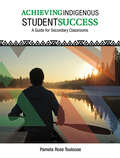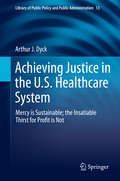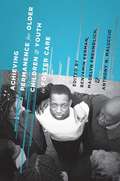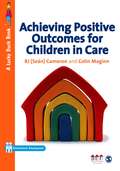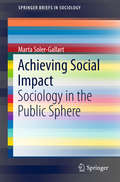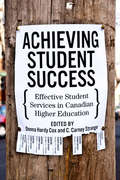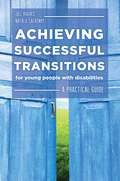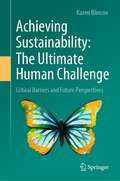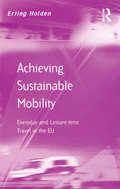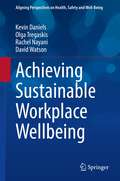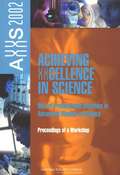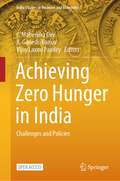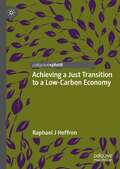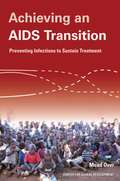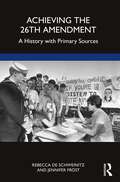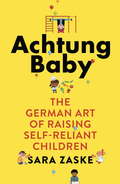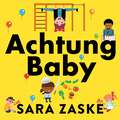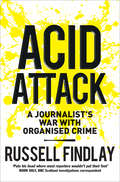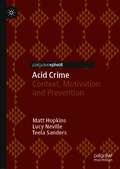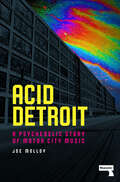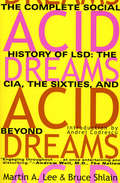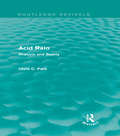- Table View
- List View
Achieving Indigenous Student Success: A Guide for Secondary Classrooms
by Pamela Rose ToulouseIn Achieving Indigenous Student Success, author Pamela Toulouse provides strategies, lessons, and hands-on activities that support both Indigenous and non-Indigenous learners in the secondary classroom. Read chapters on topics such as:Indigenous Pedagogy and Classrooms ConsiderationsIndigenous Self-Esteem and Mental Health ActivitiesDifferentiated Instruction and Bloom's TaxonomyAttrition, Retention, Transition, and Graduation ContinuumIndigenous Themes and Material ResourcesCulturally Appropriate Secondary Lesson Plans by Subject (including English, Math, Science, History, Geography, Health, Physical Education, Drama, Music, Visual Arts, Technological Studies, Business Studies, Indigenous Worldviews, Guidance and Career Studies, and Social Studies and the Humanities)This book is for all teachers of grades 9–12 who are looking for ways to infuse Indigenous perspectives into their courses. Ideas include best practices for retention/transition/graduation planning, differentiated instruction, assessment, and equity instruction. Using appropriate themes for curricular connections, the author presents a culturally relevant and holistic approach that helps to build bridges between cultures and fosters self-esteem in all students.
Achieving Justice in the U.S. Healthcare System: Mercy is Sustainable; the Insatiable Thirst for Profit is Not (Library of Public Policy and Public Administration #13)
by Arthur J. DyckThis book focuses on justice and its demands in the way of providing people with medical care. Building on recent insights on the nature of moral perceptions and motivations from the neurosciences, it makes a case for the traditional medical ethic and examines its financial feasibility. The book starts out by giving an account of the concept of justice and tracing it back to the practices and tenets of Hippocrates and his followers, while taking into account findings from the neurosciences. Next, it considers whether the claim that it is just to limit medical care for everyone to some basic minimum is justifiable. The book then addresses finances and expenditures of the US health care system and shows that the growth of expenditures and the percentage of the gross national product spent on health care make for an unsustainable trajectory. In light of the question what should be changed, the book suggests that overdiagnosis and medicalizing normal behavior lead to harmful, costly and unnecessary interventions and are the result of unethical behavior on the part of the pharmaceutical industry and extensive ethical failures of the FDA. The book ends with suggestions about what can be done to put the U.S. health care system on the path to sustainability, better medical care, and compliance with the demands of justice.
Achieving Permanence for Older Children and Youth in Foster Care
by Benjamin Madelyn Freundlich Anthony Maluccio Eds. KermanThrough a novel integration of child welfare data, policy analysis, and evidence-informed youth permanency practice, the essays in this volume show how to achieve and sustain family permanence for older children and youth in foster care. Researchers examine what is known about permanency outcomes for youth in foster care, how the existing knowledge base can be applied to improve these outcomes, and the directions that future research should take to strengthen youth permanence practice and policy. Part 1 examines child welfare data concerning reunification, adoption, and relative custody and guardianship and the implications for practice and policy. Part 2 addresses law, regulation, court reform, and resource allocation as vital components in achieving and sustaining family permanence. Contributors examine the impact of policy change created by court reform and propose new federal and state policy directions. Part 3 outlines a range of practices designed to achieve family permanence for youth in foster care: preserving families through community-based services, reunification, adoption, and custody and guardianship arrangements with relatives. As growing numbers of youth continue to "age out" of foster care without permanent families, researchers, practitioners, and policymakers have increasingly focused on developing evidence-informed policies, practices, services and supports to improve outcomes for youth. Edited by leading professionals in the field, this text recommends the most relevant and effective methods for improving family permanency outcomes for older youth in foster care.
Achieving Positive Outcomes for Children in Care (Lucky Duck Books)
by Colin Maginn R. J. Seán CameronFor over a decade and with the best of intentions, the U. K. government has spent millions attempting, but largely failing, to improve personal, social and educational outcomes for children and young people in public care. In this book, the authors explain why the problems of this highly vulnerable group have resisted such effort, energy and expenditure and go on to show how achieving positive outcomes for children in care is possible when the root causes of failure are tackled. Topic covered include: - The power of parenting - The impact of parental rejection on emotional development - Support for the adaptive emotional development of children and young people - Practical advice on introducing the 'Authentic Warmth' approach into existing childcare organisations - Future issues in childcare This book is essential reading for carers, commissioners, policymakers, support professionals, designated teachers and students of social work.
Achieving Social Impact: Sociology in the Public Sphere (SpringerBriefs in Sociology)
by Marta Soler-GallartThis book presents the findings of research projects conducted by CREA (Community of Researchers on Excellence for all), a research community based in Barcelona, showing how social transformation combines scientific excellence with the political and social impact of the research. Analyzing the impact of pursuing social sciences research by providing examples of achievements and opportunities despite barriers and obstacles encountered along the way, it is of interest for a broad spectrum of scholars from the field of social sciences - particularly public sociology - as well as from other sciences such as biology and neuroscience.
Achieving Student Success: Effective Student Services in Canadian Higher Education
by C. Carney Strange Donna Hardy CoxThis incisive and luminescent story, scrupulously grounded in sixteenth-century sources, illuminates the power that "naming" has to create a world - in this case a world still haunted by being the accidental Indies. It is a book about how we perceive and represent the world around us, about the creative and destructive power of language. Through its elaboration of the rich and lively ironies of the Columbus story, The Accidental Indies looks at the nature of storytelling itself.
Achieving Successful Transitions for Young People with Disabilities: A Practical Guide
by Jonathan Monk Jill Hughes Natalie LackenbyThis best practice guide provides a blueprint for managing seamless transitions between services for young people aged 16-25 with additional needs, including learning disabilities, physical disabilities, complex health needs and sensory impairments. The authors cover a wide range of transitions, including moving from children's to adult's services, from school to college, leaving education and gaining work experience and employment and supporting young people to live independently. They include key information on policy and legislation, the statutory duty of local authorities and health, housing and education agencies, and describe the impact of the new Education, Health and Care (EHC) Plans. With a wealth of practical, common sense guidance for navigating this complex area of work in a timely, efficient and cost-effective manner, the book will guide practitioners and students step-by-step through the process of managing transitions, highlighting best practice and providing evidence-based models to ensure the best possible outcomes for service users and their families. An essential resource for all those involved in supporting young people with additional needs through transitions, including social workers and social work students, occupational therapists, speech and language therapists, health professionals and special education teachers.
Achieving Sustainability: Critical Barriers and Future Perspectives
by Karen BlincoeThe book provides an assessment of whether sustainability is realizable in the current societal framework. What are the challenges and the barriers - and what are the levers necessary to meet and overcome them?Through a revision of the essence of sustainability the book provides an opportunity to understand the deeper level of the radical change that sustainability represents, and the resistance that is preventing its realization.To build the argument the sustainable development model is compared with current development theories as well as alternative solutions based on utopian models of the past. The book assesses the results that can be achieved within the current systemic framework, based on case stories. It outlines the limitations to sustainability, pointing out and defining the multiple, cross-sectoral and systemic barriers that hinder the transition.Finally, the book offers perspectives on achieving a sustainable future, encompassing the impacts from recent events including the pandemic as well as the multiple mitigation and transition initiatives undertaken globally.Brian Goodwin's QuoteLike the caterpillar that wraps itself up in its silken swaddling bands prior to its metamorphosis into a butterfly, we have wrapped ourselves in a tangled skin from which we can emerge only by going through a similarly dramatic transformation.
Achieving Sustainable Mobility: Everyday and Leisure-time Travel in the EU (Transport and Mobility)
by Erling HoldenSustainable mobility has become the new imperative for transport policy. There have been a number of policy attempts at sustainable mobility globally, such as the development of more efficient conventional transport technologies, the promotion of efficient and affordable public transport systems and the encouragement of environmental awareness. Such policies have so often been presented as prerequisites for sustainable mobility that they are now taken for granted. But are any of these policies really successful? To what extent do they actually contribute (or fail to contribute) to sustainable mobility? Why do some policies succeed and others fail? Using an interdisciplinary approach which brings together various theories and methodologies, this book tests each of these policies - or hypotheses, as the author sees them - with detailed empirical investigations. It also argues that leisure-time travel should be included in any sustainable mobility policies, as it now accounts for 50 per cent of all annual travel distance in developed countries. The book concludes by suggesting fourteen theses of sustainable mobility for the EU and a new model for future best practice.
Achieving Sustainable Workplace Wellbeing (Aligning Perspectives On Health, Safety And Well-being Ser.)
by David Watson Kevin Daniels Olga Tregaskis Rachel NayaniIn this groundbreaking interdisciplinary work, the authors focus on organizational analysis to understand workplace wellbeing, deviating from previous research that mostly looks at the individual worker or intervention. In addressing the question of why workplace health and wellbeing practices initiatives fall short of delivering sustained improvements in worker wellbeing, this book moves beyond localized explanations of the failure of specific interventions. Instead, it creates theoretical frameworks that explain how wellbeing at work can be improved and sustained. The authors use evidence from systematic and comprehensive surveys of the literature as well as new empirical research, and present an explanatory framework of the processes through which organizations change to implement and accommodate workplace health and wellbeing practices. Learning, adaptation and continuation explain successful implementation of workplace health and wellbeing practices, while Gestalting, fracturing and grafting explain how organizations resolve or negotiate conflict between health and wellbeing practices and existing organizational procedures, systems and practices. In addition, the authors reflect on the implications for research of reframing the unit of analysis as the organization and how studies on workplace wellbeing practices can provide a conceptual platform for thinking about the way organizations can create social value in a broader sense. This book, authored by experts in their field, is a great resource for academics and professionals of organizational studies and of worker wellbeing across the social sciences, behavioural sciences, business and management courses, wellbeing research, and labour studies.
Achieving UN Sustainable Development Goal 8: Economic Growth and Decent Work For All (Environment for Development)
by Gunnar Köhlin Lotta Dellve Sharon Fonn Katrin SkagertThis book brings together knowledge on how to achieve the UN Sustainable Development Goal 8, to bring societal change through sustainable economic growth and decent work for all by 2030.At its core is the great challenge of achieving economic growth without compromising the environment, while ensuring respect for fundamental human rights, and in particular the right to employment with equal and safe work conditions. This book provides a critical analysis of Sustainable Development Goal (SDG) 8 in the 2030 Agenda, its targets and indicators, to reveal biases, tensions and contradictions that need to be addressed to achieve this goal and to guide policymaking. The role and potential of academia to contribute to achieving this SDG is scrutinized. Chapters examine and assess specific targets for SDG 8, which includes policies, resource efficiency, youth employment, child labour and sustainable tourism. Higher education institutions’ tools for capacity building are presented, examining how education and academic research can play a role in achieving the SDG 8 targets. Overall, this book offers a synthesis of how research and higher education can make a difference in achieving a complex SDG.This book will be of great interest to academics and professionals working on the United Nations Sustainable Development Goals and can be used as a policymaking guide for 2030 and beyond.
Achieving Xxcellence in Science: Role of Professional Societies in Advancing Women in Science
by Committee on Women in Science EngineeringThis report is the proceedings of a July 2002 workshop of the Committee on AXXS 2002: A Workshop for Clinical Societies to Enhance Women's Contributions to Science and their Profession. The workshop gathered representatives of clinical societies and identified ways to enhance the participation of women scientists in the clinical research workforce. This workshop was a follow-up to the AXXS 1999 conference sponsored by the Office of Research on Women's Health (ORWH) at the National Institutes of Health (NIH), which focused on how scientific societies could contribute to the enhancement of women's careers in science.
Achieving Zero Hunger in India: Challenges and Policies (India Studies in Business and Economics)
by S. Mahendra Dev A. Ganesh-Kumar Vijay Laxmi PandeyThis open access volume discloses rich set of findings and policy recommendations for India towards achieving the SDG 2.1 target of zero hunger by 2030. Through its fourteen chapters, it takes an integrated approach by examining diverse aspects of food and nutrition security through multidisciplinary lens of Agricultural Economics, Nutrition, Crop Sciences, Anthropology and Law, while being rooted in economics. The chapters reflect this diversity in disciplines in terms of the questions posed, the data sets used, and the methodologies followed. Starting from the evolution of policy response for hunger and nutrition security, the book covers aspects such gender budgeting, dietary diversity, women’s empowerment, calorie intake norms, socio-legal aspects of right to health, subjective wellbeing, bio-fortification, crop insurance and food security linkages, interdependence of public distribution system (for food security) and employment guarantee schemes especially during COVID-19 pandemic, effects of dairy dietary supplements, and so on. With its rich discussions, the book is compelling for students, researchers, policy makers, development professionals and practitioners working in areas of food and nutrition security, SDGs, in particular SDG1, SDG2 and SDG5, and sustainable food systems.
Achieving a Just Transition to a Low-Carbon Economy
by Raphael J HeffronThe ambition of most countries across the world is to develop a low-carbon economy, evidenced by the fact that the vast majority of countries have signed the Paris COP21 agreement. This book contends that this global societal transition to a low-carbon economy must be just. As such, it will be an invaluable and accessible reference for scholars from all research disciplines who aim in their research to see a fairer, more equitable and inclusive world where sustainability is at the fore and climate targets are achieved.This is the first in-depth and original analysis to explore the central importance of law in achieving a just transition to a low-carbon economy. In addition, it advances the JUST framework, a unique framework for assessing the just transition. This important research and theoretical tool provides a practical perspective as it ensures the geographical space and timelines of development are factored into analysis. The research also provides analysis on the just transition movement around the world and the influence of international institutions.Through several case studies on Just Transition Commissions and Critical Mineral Development, the book details and demonstrates key elements of justice, including distributive, procedural, restorative, recognition, and cosmopolitan justice. It is clear from the analysis that while these are vast areas for analysis, if applied in practice, they all centrally contribute to ensuring society will advance in achieving a just transition to a low-carbon economy.
Achieving an AIDS Transition
by Mead OverFive million people in poor countries are receiving AIDS treatment, but international AIDS policy is still in crisis. Donors are giving less than they had been, even though infections continue unabated, and the number of people dependent on treatment rises each year.This book proposes a feasible medium-term objective for AIDS policy: achieving an "AIDS transition," that is, keeping AIDS deaths down by sustaining treatment while pushing new infections even lower, so that the total number of people living with HIV/AIDS begins to decline. How? Through a new, incentive-driven strategy to improve HIV prevention and a sustained effort to get the most from AIDS treatment.
Achieving the 26th Amendment: A History with Primary Sources
by Jennifer Frost Rebecca de SchweinitzThis book is a collection of primary source documents and analysis that illustrates the forgotten history of the fight to lower the voting age to eighteen in the twentieth-century United States. Proposed, passed, and ratified in 1971, the 26th Amendment gave the right to vote to 18-, 19-, and 20-year-olds and prohibited discrimination in voting “on account of age.” Recognizing young Americans as first-class citizens with a political voice, it was the last time the United States extended voting rights to a new group. From the early 1940s to the early 1970s, Americans debated the merits of a younger voting age and built a movement across age, party, and regional differences for the 26th Amendment. The struggle for youth suffrage intersected with key events and developments during these years, such as World War II, the Vietnam War, the African American movement for civil and voting rights, the baby boom and youth activism. With historical images and excerpts from government documents, pamphlets, organizational and personal collections, mainstream and campus newspapers, and magazines, this book presents a rich portrait of the struggle for youth enfranchisement. Achieving the 26th Amendment: A History with Primary Sources is an ideal resource for students and professors in twentieth-century United States history, civics and government, and social movements and activism.
Achtung Baby: The German Art of Raising Self-Reliant Children
by Sara ZaskeAn entertaining, enlightening look at the art of raising self-reliant, independent children based on one Mum's experiences in Germany.'Warm and companionable . . . I closed Achtung Baby feeling more relaxed and confident. While both my kids were up a tree.' - Helen Brown, Daily MailWhen Sara Zaske moved from Oregon to Berlin with her husband and toddler, she was surprised to discover that German parents give their children a great deal of freedom. In Berlin, kids walk to school by themselves, ride the subway alone, cut food with sharp knives and even play with fire. German parents did not share her parental fears and their children were thriving. Was she doing the opposite of what she intended, which was to raise capable children? Through her own family's often funny experiences as well as interviews with other parents, teachers, and experts, Zaske shares the many unexpected parenting lessons she learned from living in Germany. Achtung Baby reveals that today's Germans know something that other parents don't (or have perhaps forgotten) about raising kids with 'selbstandigkeit' (self-reliance), and provides many new and practical ideas parents everywhere can use to give their own children the freedom they need to grow into responsible, independent adults.
Achtung Baby: The German Art of Raising Self-Reliant Children
by Sara ZaskeAn entertaining, enlightening look at the art of raising self-reliant, independent children based on one Mum's experiences in Germany.'Warm and companionable . . . I closed Achtung Baby feeling more relaxed and confident. While both my kids were up a tree.' - Helen Brown, Daily MailWhen Sara Zaske moved from Oregon to Berlin with her husband and toddler, she was surprised to discover that German parents give their children a great deal of freedom. In Berlin, kids walk to school by themselves, ride the subway alone, cut food with sharp knives and even play with fire. German parents did not share her parental fears and their children were thriving. Was she doing the opposite of what she intended, which was to raise capable children? Through her own family's often funny experiences as well as interviews with other parents, teachers, and experts, Zaske shares the many unexpected parenting lessons she learned from living in Germany. Achtung Baby reveals that today's Germans know something that other parents don't (or have perhaps forgotten) about raising kids with 'selbstandigkeit' (self-reliance), and provides many new and practical ideas parents everywhere can use to give their own children the freedom they need to grow into responsible, independent adults.
Acid Attack: A Journalist's War With Organised Crime
by Russell Findlay&“A good gritty read . . . expect your heart to race&” from a journalist who took on Scotland&’s most dangerous mob bosses—and paid the price (Gina McKie, DJ and radio legend). Two days before Christmas 2015, veteran crime journalist Russell Findlay was the target of a vicious attack on his own doorstep. An unknown assailant, disguised as a postman, hurled sulphuric acid in his face before attempting to stab him with a steak knife. Despite suffering horrific burns, Findlay managed to overcome his assailant before the police arrived. In this book he unravels the identity of the man who ordered the hit and reflects on a two-decade career during which he has exposed some of Scotland&’s most violent and dangerous men. The result is an unflinchingly realistic portrait of the country&’s criminal underworld, involving not just organized crime&’s most notorious bosses but also murky behavior by lawyers, politicians, policemen and even fellow journalists which has enabled the criminals to flourish.&“Cast[s] light on the reality of Glasgow&’s vicious gang culture and the dangers for those brave enough to report on it.&” —The Guardian&“Puts his head where most reporters wouldn&’t put their feet.&” —Mark Daly, BBC Scotland investigations correspondent&“I&’ve read it twice, it&’s an utterly fascinating book.&” —Tam Cowan, BBC Radio Scotland&“Real journalism is still practiced by brave individuals. I use that word deliberately, because it takes courage to expose the dangerous, violent and depraved. Russell Findlay displays that courage.&” —Joan McAlpine, MSP, Daily Record
Acid Attacks in Britain, 1760–1975 (World Histories of Crime, Culture and Violence)
by Katherine D. WatsonThis Palgrave Pivot examines the history of the largely urban offence once known as vitriol throwing because the substance most commonly used was strong sulphuric acid, oil of vitriol. A relatively rare form of assault, it was motivated largely by revenge or jealousy and, because it was specifically designed to blind and mutilate, commonly targeted the victim’s face. The incidence of what was thus widely acknowledged to be an exceptionally cruel crime plateaued in the period 1850–1930 amid a sometimes surprisingly lenient legal response, before declining as a result of post-war social changes. In examining the factors that influenced both the crime and its punishment, the book makes an important contribution to criminal justice history by illuminating the role of gender, law and emotion from the perspective of both victim and perpetrator.
Acid Crime: Context, Motivation and Prevention (Palgrave Studies in Risk, Crime and Society)
by Teela Sanders Lucy Neville Matt HopkinsThis book provides an authoritative overview of the contemporary phenomenon widely labelled as ‘acid attacks’. Although once thought of as a predominantly ‘gendered crime’, acid and other corrosive substances have been used in a range of violence crimes. This book explores the historical use of corrosives in crime, legal definitions of such attacks, the contexts in which corrosives are used, victim characteristics, offender motivations for carrying and decanting corrosives, and preventative strategies. Data is drawn from the international literature and the analysis of primary data collected in the UK (which is thought to have one of the highest rates of acid attacks in the world) from interviews with over 20 convicted offenders and from police case files relating to over 1,000 crimes involving corrosive substances. This book adds significantly to the international literature on weapons carrying and use, which to date has predominantly focused around the possession and use of guns and knives.
Acid Detroit: A Psychedelic Story of Motor City Music
by Joe MolloyAcid Detroit tells the story of Motor City through its revolutionary music past and present, in order to find the seeds of radical transformation among its ruins.Acid Detroit is an exhilarating, technicolour view of Detroit&’s musical and social history from the 1960s to the present day. Redefining the counterculture as a time of Acid Communism, Acid Detroit diverges from most books on the Sixties, which centre on California, to show that Detroit was an unequalled hotbed of radical activism, urban unrest and sonic innovation. Considering Detroit's unique mix of people and cultures and enduring sonic legacies, it covers everything from incendiary garage rock, to European-influenced techno and experimental hip-hop crews, intertwining the artist&’s lives and works with the city&’s rise and decline, from its establishment as an industrial powerhouse to the high point of Motor City, into its decline and tentative rebirth. A mind-expanding tour through time and space that explores the lost possibilities, histories and hidden potentials of the city, Acid Detroit reveals a history of resilience and transformation hidden in the shadows of the abandoned factories and warehouses of the Motor City.
Acid Dreams: The Complete Social History of LSD: The CIA, the Sixties, and Beyond
by Martin A. Lee Bruce Shlain“An engrossing account” of the history of LSD, the psychedelic 1960s, and the clandestine mind games of the CIA (William Burroughs). Beginning with the discovery of LSD in 1943, this “monumental social history of psychedelia” tracks the most potent drug known to science—from its use by the government during the paranoia of the Cold War to its spill-over into a revolutionary antiestablishment recreation during the Vietnam War—setting the stage for one of the great ideological battles of the decade (The Village Voice). In the intervening years, the CIA launched a massive covert research program in the hope that LSD would serve as an espionage weapon; psychiatric pioneers came to believe that acid would shed light on the perplexing problems of mental illness; and a new generation of writers and artists in countercultural transition sought to break the “mind-forged manacles” of a new generation in rebellion—among them, Timothy Leary, Ken Kesey, the Beatles, Allen Ginsberg, William Mellon Hitchcock, and Abbie Hoffman. Painting an indelible portrait of an unforgettable era and using startling information obtained through the Freedom of Information Act, Acid Dreams also exposes one of the most bizarre, shocking, and often tragic episodes in American history. “An important historical synthesis of the spread and effects of a drug that served as a central metaphor for an era.” —John Sayles “Marvelously detailed . . . loaded with startling revelations.” —Los Angeles Daily News
Acid Hype: American News Media and the Psychedelic Experience
by Stephen SiffNow synonymous with Sixties counterculture, LSD actually entered the American consciousness via the mainstream. Time and Life, messengers of lumpen-American respectability, trumpeted its grand arrival in a postwar landscape scoured of alluring descriptions of drug use while outlets across the media landscape piggybacked on their coverage with stories by turns sensationalized and glowing. Acid Hype offers the untold tale of LSD's wild journey from Brylcreem and Ivory soap to incense and peppermints. As Stephen Siff shows, the early attention lavished on the drug by the news media glorified its use in treatments for mental illness but also its status as a mystical--yet legitimate--gateway to exploring the unconscious mind. Siff's history takes readers to the center of how popular media hyped psychedelic drugs in a constantly shifting legal and social environment, producing an intricate relationship between drugs and media experience that came to define contemporary pop culture. It also traces how the breathless coverage of LSD gave way to a textbook moral panic, transforming yesterday's refined seeker of truths into an acid casualty splayed out beyond the fringe of polite society.
Acid Rain: Rhetoric and Reality (Routledge Revivals)
by Chris C. ParkThis title, first published in 1987, provides an authoritative account of both the science and the politics of acid rain. Chris Park places the debates surrounding acid rain in context, and examines the full implications of scientific studies and the effects of acid rain on surface waters, soils and buildings. Evidence is drawn from around the world, including an examination of the damage in Scandinavia and Germany and the effects of acid rain in the U.K. and U.S.A. A comprehensive and relevant work, this is an important guide for students of geography, environment and sustainability and energy policy.
